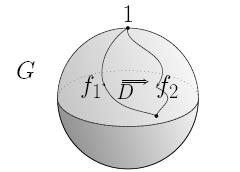

Here you can see a set of related talks that John Baez,
Alex Hoffnung and Chris
Rogers gave in Göttingen.
Click on these to see transparencies of the talks:
Lectures on Higher Gauge Theory
John Baez
Gauge theory describes the parallel transport of point particles using
the formalism of connections on bundles. In both string theory and loop
quantum gravity, point particles are replaced by 1-dimensional extended
objects: paths or loops in space. This suggests that we seek some sort
of "higher gauge theory" that describes parallel transport as we move a
path through space, tracing out a surface. To find the right mathematical
language for this, we must "categorify" concepts from topology and geometry,
replacing smooth manifolds by smooth categories, Lie groups by Lie 2-groups,
Lie algebras by Lie 2-algebras, bundles by 2-bundles, sheaves by stacks or
gerbes, and so on. This overview of higher gauge theory will emphasize its
relation to homotopy theory and the cohomology of groups and Lie algebras.
Here is some reading material for Lecture 1, on Lie 2-groups
and Lie 2-algebras:
For more on the string group, try:
Here is some reading material for Lecture 2, on 2-bundles and
classifying spaces for 2-groups:
Here is some reading material for Lecture 3, on 2-connections
on 2-bundles:
For more on interpreting Chern-Simons theory and BF theory
as higher gauge theories, see:
For more on interpreting M-theory and 11-dimensional supergravity as higher
gauge theories, see:
Smooth Spaces: Convenient Categories for Differential Geometry
Alexander Hoffnung
In 1977 K.T. Chen introduced a notion of smooth spaces as a generalization
of the category of smooth manifolds. In 1979 Souriau introduced another
notion, "diffeological spaces", serving the same purposes.
Both of these categories have all limits and colimits, and are cartesian
closed. In fact, following ideas of Dubuc, we give a unified proof that
the categories of Chen spaces, diffeological spaces, and simplicial
complexes are "quasitopoi" locally cartesian closed categories
with finite (and in these cases all) colimits and a weak subobject classifier.
The transparencies are available
here.
For more details, see:
Just as symplectic geometry is a natural setting for the classical mechanics of point particles, 2-plectic geometry can be used to describe classical strings. Just as a symplectic manifold is equipped with a closed non-degenerate 2-form, a "2-plectic manifold" is equipped with a closed non-degenerate 3-form.The transparencies are available here.The Poisson bracket makes the smooth functions on a symplectic manifold form a Lie algebra. Similarly, any 2-plectic manifold gives a "Lie 2- algebra": the categorified analogue of a Lie algebra, where the usual laws hold only up to isomorphism. We explain these ideas and use them to give a new construction of the "string Lie 2-algebra" associated to a simple Lie group.
For more details, see: